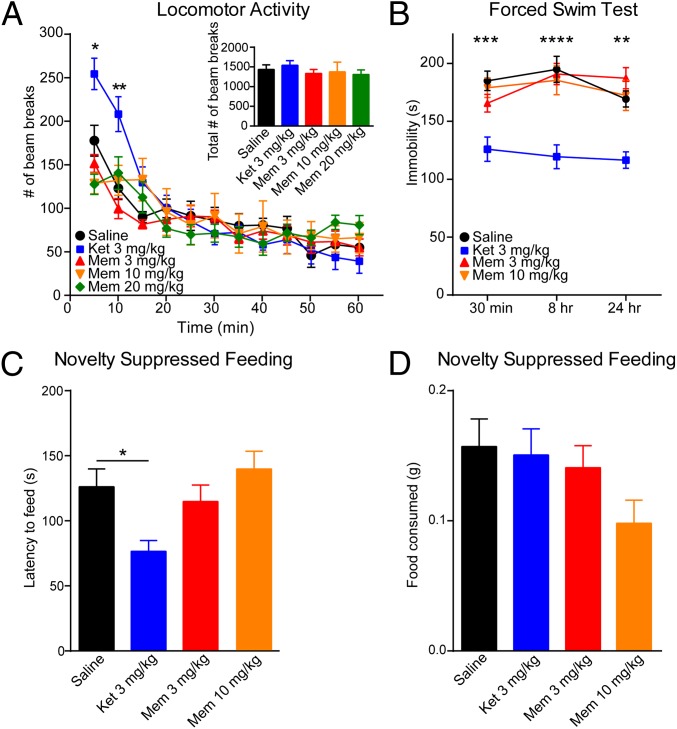Fig. 1.
Memantine (Mem) treatment does not cause a fast-acting antidepressant effect. (A) Ketamine (Ket) causes a significant increase in locomotor activity at the 5- and 10-min intervals [two-way ANOVA interaction: F44,420 = 1.904, P = 0.0007; time: F11,420 = 25.87, P < 0.0001; treatment effects: F4,420 = 2.784, P = 0.0264; Tukey’s post hoc analysis for Ket: 5 min vs. saline, *P = 0.01; 10 min vs. saline, **P = 0.001 (n = 8 per group)]. (Inset) There were no significant differences in the total number of beam breaks over 1 h. (B) Ket treatment caused a significant decrease in immobility in the FST compared with the saline control group at 30 min, 8 h, and 24 h following injection, whereas Mem (3 mg/kg and 10 mg/kg) did not cause a significant decrease in immobility time [two-way ANOVA: F3,107 = 28.96, P < 0.0001; Tukey’s post hoc analysis for Mem: 30 min: saline vs. Ket, ***P = 0.0002; saline vs. 3 mg/kg Mem, P = 0.501; saline vs. 10 mg/kg Mem, P = 0.972 (n = 9–10 per group); 8 h: saline vs. Ket, ****P < 0.0001, saline vs. 3 mg/kg Mem, P = 0.991; saline vs. 10 mg/kg Mem, P = 0.904; 24 h: saline vs. Ket, **P = 0.0017, saline vs. 3 mg/kg Mem, P = 0.584; saline vs. 10 mg/kg Mem, P = 0.996]. (C) Single dose of Mem treatment (30 min: 3 mg/kg or 10 mg/kg) did not have an impact on latency to feed in the NSF test compared with the saline-treated group. However, acute Ket treatment (3 mg/kg) results in a significant decrease in latency to feed compared with saline [ANOVA: F3,35 = 4.97, *P = 0.0056; Bonferroni’s post hoc comparison: saline vs. 3 mg/kg Mem, P > 0.9999; saline vs. 10 mg/kg Mem, P > 0.999; saline vs. Ket, P = 0.0465 (n = 9–10 per group)]. (D) Appetite posttest following the NSF test indicates that the total amount of food consumed is indistinguishable across groups (ANOVA: F3,35 = 1.999, P = 0.1321).

